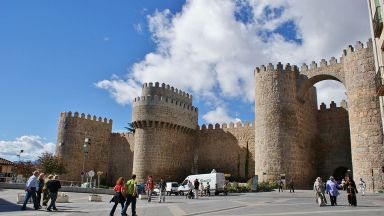Palacio de los Dávila (Ávila)
Palace in Ávila

The palace was built between the 13th century and the 16th. For this reason, a juxtaposition of styles can be noticed in its design. The oldest part seems to be the gate of the Rastro, or street market. The palace is attached to the fortified wall.
The walls had an interior second line of defence made up of the palaces and mansions inhabited by the nobles and clergy. Built next to the interior of the walls, they assured defence from popular revolts and/or enemy attacks on the town. This is the case of the Palace of Los Dávila, which, built on the south side, is a prime example of a fortified mediaeval palace.
Built in the 13th century in the same granite material as the walls, different elements were added until the 16th century. The west front, with geminate windows on the upper floor, dates from the 13th century and has a pointed Gothic porch. The front has a second lintelled door from the 14th century.
The machicolations and merlons on the north front show how the palace was used for defence purposes. Besides the Gothic-style geminate windows, there are two doors with semi-circular arches and large voussoirs. Above the door positioned furthest to the west, there are reliefs of two wild animals chained and flanked by two knights with trumpets.
The building is completed by a Renaissance window from 1541, whose construction was ordered by Pedro Dávila. It is framed by small columns and finished off at the front with the coat of arms of Los Dávila. At the time, the gates in the walls were closed at night. To avoid the prohibition, a door was opened in the walls without permission. After its closure, Pedro Dávila, incensed by the command he had been given, ordered the construction of this window with the legend ‘Where one door closes, another one opens’.
At midday, the 16th-century gallery-vantage point that opens on the walls above the Gate of El Rastro becomes particularly interesting.
The courtyard, which is home to two Vetton animal sculptures, shows the importance of the Mudejar tradition in our architecture, as in other places inside the palace.
The Palacio de los Dávila (Ávila) appears in our Complete Guide to Visiting Ávila!
This website uses affiliate links which may earn a commission at no additional cost to you!
Visiting Palacio de los Dávila (Ávila)
Nearby Attractions
- Palacio de los Guzmanes (Ávila) (0.1) km
Palace in Ávila - Palacio de Los Superunda (Ávila) (0.1) km
Palace in Ávila - Church of San Juan Bautista (Ávila) (0.1) km
Church in Ávila - Palacio de Los Almarza (Ávila) (0.1) km
Palace in Ávila - Plaza Mercado Chico (0.1) km
Square in Ávila - El Convento de Santa Teresa (0.2) km
Convent in Ávila - Palacio de Valderrábanos (Ávila) (0.2) km
Palace in Ávila - Puerta de Santa Teresa, Ávila (0.2) km
City Gate in Ávila - Los Velada Palace (Ávila) (0.2) km
Hotel and Palace in Ávila - Palacio de Núñez Vela (Ávila) (0.2) km
in Ávila


